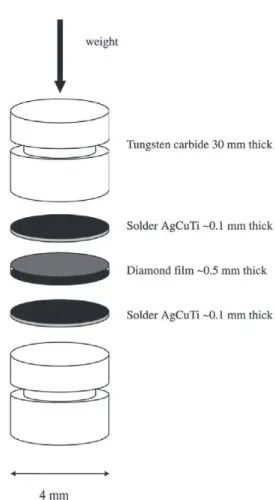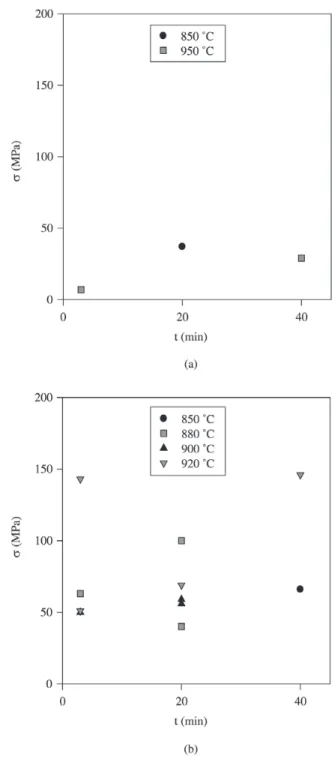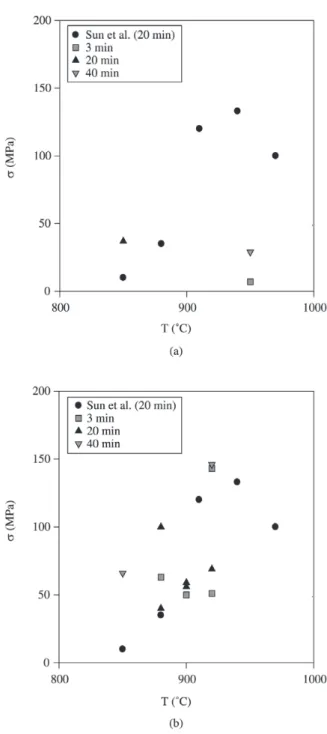*e-mail: ssantos@if.ufrgs.br
Articles presented at the XV CBECIMAT, Natal - RN, November de 2002.
Evaluation of the Adhesion Strength of Diamond Films Brazed
on K-10 Type Hard Metal
Sérgio Ivan dos Santosa*, Carlos Alberto Medeiros Casanovab
Cleiton Rodrigues Teixeirab, Naira Maria Balzarettia, João Alziro Herz da Jornadaa,c a
Av. Bento Gonçalves, 9500 Campus do Vale - Instituto de Física - LAPMA UFRGS, C.P. 15051, 91501-970 Porto Alegre – RS, Brazil b
Depto. Materiais de Construção - FURG, Rio Grande – RS, Brazil c
INMETRO, Xerém – RJ, Brazil
Received: January 29, 2003; Revised: November 10, 2003
The coating of cutting tools with diamond films considerably increases the tool performance due to the combination of the unique tribological properties of diamond with the bulk properties of the substrate (toughness). The tool performance, however, is strongly related to the adhesion strength between the film and the substrate. In this work our main goal was to propose and to test a procedure, based on a tensile strength test, to evaluate the adhesion strength of a diamond wafer brazed on a hard metal substrate, taking into account the effect of the brazing temperature and time. The temperature range studied was from 800 to 980 °C and the brazing time ranged from 3 to 40 min. The obtained results could be used to optimize the costs and time required to the production of high performance cutting tools with brazed diamond wafers.
Keywords: brazing, diamond, CVD, adhesion strength, cutting tool
1. Introduction
Diamond has unique tribological properties that are very useful for technological applications. In the field of machin-ing of very abrasive non-ferrous materials, for instance, the performance of diamond tools is outstanding1,2. Polycrystalline diamond inserts (PCD) on tungsten carbide substrates are widely used in industry. They are produced by high pressure-high temperature (HP-HT) sintering of diamond grains with a metallic binder, usually cobalt. The direct deposition of a thin diamond film by the CVD (Chemical Vapor Deposition) technique on a tungsten carbide tool surface is an alternative way of coating cutting tools with planar and non-planar shapes. To enhance the adhesive strength between the diamond film and the substrate, a pre-treatment of the tungsten carbide is required in order to decrease the deleterious effect of its co-balt content on the diamond deposition1. The surface rough-ness of the growing side of the diamond film will be trans-ferred to the machined workpiece and, for some applications, the polishing of the diamond film will be required.
Brazing a thick CVD diamond wafer (~500 µm) over a
tungsten carbide substrate with a metallic solder is another way of producing diamond tools. During machining opera-tion, the diamond wafer will behave similarly to the PCD insert but without the presence of the metallic binder in the region in contact with the workpiece. This region usually reaches high temperatures and the presence of the binder would increase the wear rate of the PCD tool compared to the CVD brazed tool. Moreover, the rough growing side of the diamond wafer can be brazed in contact with the tung-sten carbide substrate, while the smooth wafer side would act as the cutting tool surface, producing a small surface roughness of the workpiece. The adhesion strength of the brazed tool can be optimized by choosing the appropriate solder and brazing conditions, and there is no need to pre-treat the tungsten carbide substrate before brazing.
Nowadays it is possible to grow thick CVD diamond wafers with large area at relatively low cost. Brazing as a method of joining metals is known for hundreds of years, and consists of using a low melting point metal to bond two metallic components4. However, the chemical inertness of diamond requires the use of special solders for brazing, containing a small amount of transition elements which ac-tively react with carbon. This reactivity would be responsi-ble for the joining of the diamond wafer to the tungsten carbide substrate. Metallic alloys containing Ag-Cu and a small concentration of Ti has been used to braze diamond films3,4. The Ti atoms are responsible for the reactivity with both diamond and tungsten carbide through the TiC forma-tion5. However, due to the strong reactivity of Ti with oxy-gen, the brazing procedure has to be performed under vacuum or inert atmosphere and high temperature. The braz-ing filler should also remain ductile and reduce the thermal stress between the diamond wafer and the substrate3. The carbide formation induced by the Ti active atoms will de-pend on their diffusivity under the brazing conditions and, therefore, the adherence strength will depend on the braz-ing atmosphere, temperature and time.
The indentation and scratch tests, conventionally used to evaluate the adhesion strength of thin diamond films de-posited over tungsten carbide substrates6-8, are not suitable for brazed tools due to the large thickness of the diamond wafer. Recently, Sun et al.5 evaluated the bonding strength of CVD diamond films brazed on WC-Co (8%) substrates with Ag-Cu-Ti alloy using a shear strength test. They con-cluded that the brazing temperature, in the range of 850 to 970 °C, does affect the shear strength of the joint and the Ti active element is the most important factor responsible for the joining through the TiC formation at the interfaces.
In this work we brazed diamond wafers (~0.5 mm) over WC-Co (6%) substrates with a Ag-Cu-Ti (8%) solder (0.1 mm thick), at temperatures from 800 to 980 oC, during 3 to 40 min. We adapted a tensile strength test to evaluate the adhesion strength as a function of the brazing tempera-ture and time and we analyzed the fractempera-tured surfaces by optical microscopy.
2. Experimental Method
2.1. Brazing procedure
The diamond wafer (0.5 mm thick and 5 cm diameter) was grown by microwave plasma deposition over a silicon substrate at the Laboratório de Altas Pressões e Materiais Avançados (LAPMA) of the Instituto de Física-UFRGS. After removing the silicon substrate by chemical etching, the diamond wafer was cut into small disks of about 4 mm diameter with a high power Nd:YAG pulsed laser. The shape of the tungsten carbide (K-10 type) substrates was conven-iently chosen to adapt them to the tensile strength test: they
were cylinders 30 mm long with 4 mm diameter. The sur-face facing the diamond disk was previously polished. Fig. 1 shows the brazing assembly, kept in the vertical position inside a ceramic holding support and submitted to a small pressure on the top by a weight of 0,165 kg.
During the brazing procedure, this set was placed in-side a silica tube with 32 mm diameter, connected to a vacuum system (10-4 torr). The heating rate of the system under vacuum, inside a tubular furnace, was 15 °C/min up to the selected brazing temperature. After heating during the desired holding time, the system was cooled under vacuum down to 400 °C, and ventilated down to the room temperature.
2.2. Tensile Strength Test
Figure 2 shows the experimental setup used to evaluate the adhesion strength between the diamond wafer and the
tungsten carbide through the tensile strength test. The tests were performed in the Laboratório de Ensaios Mecânicos -GEFMAT - FURG, using a mechanical apparatus from WERKSTOFFPRUFMASCHINEN LEIPZIG. It was de-signed and constructed a special system to hold the sample during the test to avoid damaging the machine due to the high hardness of the tungsten carbide. The indent in the tung-sten carbide cylinders represented in Fig. 1 (2 mm width and 0,6 mm depth) was used to clip the brazed samples into the machine during the test. The calibration of the load cell and of the clip gauge in the same apparatus enabled the use of its own acquisition data system to register the experi-mental data.
The tensile strength test consisted in increasing the load applied through the clips of the machine on the opposite cylinders of the brazed assembly up to the failure. The maxi-mum load supported by the assembly before failure was registered and the fractured surfaces were analyzed by opti-cal microscopy. The failure strength (σfailure) was considered
to be given by the ratio of the maximum load and the effec-tive brazed area.
3. Results and Discussion
In the literature, Sun et al.5 present results about the ad-hesion strength of diamond films brazed on hard metal us-ing the Ag-Cu-Ti system alloy at temperatures from 850 to 970 °C during 20 min. The diamond wafer was 110 µm
thick, the filler metal was 30 µm thick and the adhesion was
evaluated by a shear strength test. In the present work the adhesion strength was evaluated as a function of the braz-ing temperature, in the range from 800 °C to 980 °C, and as a function of the brazing time, from 3 to 40 min, by a tensile strength test. The diamond wafer was about 500 µm thick
and the filler metal was 100 µm.
The results showed that the minimum temperature
re-quired to successfully braze the diamond film on hard metal is 850 °C during at least 20 min. The heating up to 800 °C induces the melting of the metallic solder but the reactivity at the interface was not enough to promote the adhesion
Figure 2. Experimental setup for the tensile strength test.
between the film and the substrate, even after 40 min processing. On the other hand, the brazing was accomplished at 880 °C after 3 min processing.
The optical analysis of the fractured surfaces after the tensile strength test revealed that, in some cases, the dia-mond wafer cracked paralel to its surface for distinct
braz-ing temperatures and holdbraz-ing times. In these cases, the ad-hesion strength between the diamond wafer and the tung-sten carbide substrate was probably higher than the intrin-sic diamond film strength. Figures 3 and 4 show the results for the failure strength as a function of the brazing holding time and temperature, respectively. It is important to remark that the effective brazing area did not necessarily correspond to the total surface area of the tungsten carbide cylinder. The wettability of the solder along the interface depends on the brazing temperature and time. Thermal gradients and non-uniform contact pressure were probably responsible for the observed heterogeneous behavior. For each sample it was necessary to estimate, by optical microscopy analysis, the effective brazing area. The cases where this area was smaller than 70% of the surface area were discarded be-cause a high strength related to a small brazed area would not be useful for application in cutting tools. Figure 5 shows a SEM image of the fractured surfaces.
Figures 3b and 4b show the strength measured for those samples where the wafer cracked along its thickness during the tensile test while the interface region between the wafer
Figure 4. Failure strength as a function of the brazing temperature for distinct holding times, as indicated. a) Fracture occurred at the interface between diamond and solder; b) Fracture occurred along
and the tungsten carbide remained brazed. These values are related to the intrinsic strength of the diamond film itself. As can be seen in these figures, they ranged from 50 to 150 MPa, depending on the temperature and holding times. The results shown in Fig. 3a and 4a correspond to the brazing conditions where the fracture occurred at the joining inter-face. In these cases, the brazing strength was low, smaller than 50 MPa, indicating that the respective brazing condi-tions were not appropriate. At these condicondi-tions, correspond-ing to temperatures higher than 920 °C, the thickness of the fragile carbide layer at the interface is probably large, de-creasing the adhesion strength.
For comparison, the results of Sun et al.5 are also shown in Fig. 4, despite they did not mention where the fracture occurred during the shear strength test. The agreement is quite good and suggests that the adhesion strength is not strongly dependent on the wafer and solder thickness, neither on the evaluation test, but on the carbide formation at the interface.
4. Conclusions
The tensile strength test showed to be adequate to evalu-ate the adhesion strength of the diamond wafer brazed on hard metal. However, the reliability of the results is related to the determination of the effective brazing area, that does not necessarily correspond to the surface area of the wafer. The adherence depends on the brazing temperature and time, probably because the kinectics controlling the diffusion and reactivity of the metallic solder with the diamond wafer and with the tungsten carbide strongly depend on these param-eters, resulting in the TiC formation at the interface. It is possible to obtain good adherence for brazing temperatures as low as 850 °C but the brazing time must be at least 20 min. For temperatures higher than 920 °C, the adhesion strength decreases, probably due to the increasing thickness of the
fragile carbide layer at the interface. The best results were obtained for brazing temperatures from 880 to 920 °C, in-dependently of the holding time, from 3 to 40 min.
Acknowledgments
The authors would like to thank to the undergraduate students Henrique Gontow and João Gari da Silva Fonseca Jr. (BIC/FAPERGS) for their help with the sample prepara-tion and brazing process, and to the finnancial support from PRONEX/MCT, PADCT III/CNPq, PGCIMAT/UFRGS and FAPERGS from Brazil.
References
1. Chen, M.; Sun, F.; Zhang, Z. Key Engin. Mater., v. 196, n. 193-198, 2001.
2. Tribology Series, 28, D. Dowson, Coating Tribology: Properties, Techniques and Applications in Surface En-gineering, by K. Holmberg and A. Matthews, Elsevier, 1994.
3. Belmonte, M.; Ferro, P.; Fernandes, A.J.S.; Costa, F.M.; Sacramento, J.; Silva, R.F. Diamond Relat. Mater., v. 12, p. 738-743, 2003.
4. Benz, E. Industr. Diamond Rev., v. 51, p. 249-250, 1991. 5. Sun, J.; Feng, D.; Li, J. Mat. Proc. Techn., v. 115, p.
333-337, 2001.
6. Jindal, P.C.; Quinto, D.T.; Wolfe, G.J. Thin Sol. Films, v. 154, p. 361-375, 1987.
7. Nesládek, M.; Vandierendonck, K.; Quaeyhaegens, C.; Kerkhofs, M.; Stals, L.M. Thin Sol. Films, v. 270, p. 184-188, 1995.


